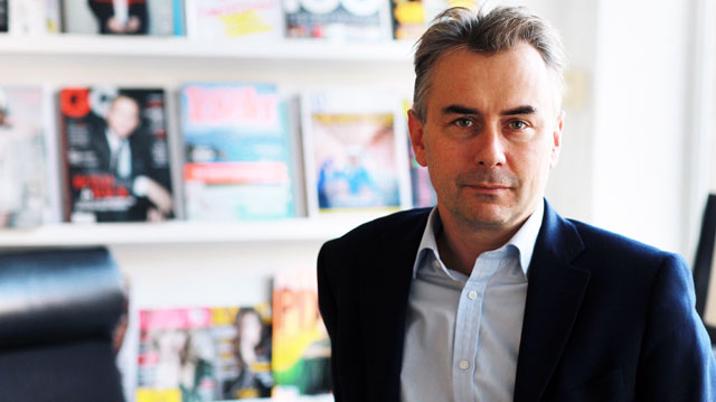
2017 has been a year of change at Condé Nast in the UK – and not just in the executive suite. Aside from the appointment of a new managing director and its first chief operating officer, the decision to formally combine marketing and digital under a new chief digital officer and a new editor at Vogue, commercial teams across six titles have been restructured, brand content studio Stories was launched and a new distribution deal secured following Condé Nast’s withdrawal from COMAG earlier this year.
“It’s about having the right structure, the right organisation, the right people, the right energy, the right attitude, the right digital talent,” says Albert Read, who assumed the role of Condé Nast Britain managing director on August 1.
“I think of Condé Nast as the owner of the luxury market. And the message to that market is that we understand it better than anyone else, and have the greatest insight into our users and readers, and can work with our advertisers to reach the people they want to reach to engage those people in the way they need to be engaged and converted to sales,” he elaborates.
“This is what we need to be sure of now as our positioning and we have to follow through and deliver that. And we can, we just have to get better and better at it as the world gets more sophisticated and as digital marketing and data become ever more closely entwined.”
Read, who joined the company in 2001 and held various positions – including Asia-Pacific director, deputy planning director, and general manager – was responsible for setting up the company’s luxury conference arm. He was promoted to deputy managing director in 2012 and worked closely with former Condé Nast Britain managing director Nicholas Coleridge until earlier this year, when he took over from his old boss; former Condé Nast International chief digital officer Wolfgang Blau replaced Coleridge as Condé Nast International president at the same time.
Right-sizing
“My priority is to right-size us for the future,” he says.
This means having the right people in the right positions and simplifying organisational structure. So, moving forward, central functions will report either to COO Sabine Vandenbroucke, who joined in September from Monocle parent company Winkreative where she was chief financial officer, or CDO Simon Gresham Jones who until recently oversaw digital advancement strategy at Burberry. With past experience, both within publishing and beyond, Read hopes Vandenbroucke’s experience will bring additional discipline and rigour to the running of the UK business.
“It will bring a whole new level of joined-up thinking around how we market subscriptions, how we use our data in this part of the building to drive acquisitions of traffic, subscribers, people buying tickets to events and so on – using all of that in a much more holistic way, so we better understand what we’ve got and how we use it,” he adds of integrating marketing into the CDO role.
“At the moment, we don’t really effectively have an overall view of this as a business. But, increasingly, this is what you need as marketing becomes digital and it becomes increasingly difficult to differentiate between the two.”
Rocky patch
One important focus over the past year has been stabilising UK performance following the portfolio’s dip in fortunes in the ABCs for the second half of last year.
Consumer magazines figures for the six months to December 2016 showed the whole UK consumer magazine market down 5.6% year-on-year. Condé Nast, however, suffered a cumulative decline for its combined titles of 8.9% year-on-year – a fall largely driven by a 26% circulation fall at Glamour to 260,422. In contrast, Vogue held steady year-on-year at 195,083 – proof, Read says, of luxury publishing’s ongoing resilience.
A subsequent reformatting of Glamour and gentle repositioning upmarket paid off during the first half of 2017, however. According to the ABCs published in August 2017, Glamour’s circulation was up to 275,536 – up 5.8% period-on-period. Meanwhile, performance elsewhere in the business was relatively stable with Vogue’s ABC of 190,021 and GQ’s total of 114,035. GQ’s digital performance is growing fast, however – online traffic to its site has doubled, and GQ unique users currently stand at 2,311,797.
“GQ’s success has come from a much tighter integration of print and digital editorial teams – in fact really, they’re just one, and that is clearly the way things should be done,” Read observes. “We have also been much more data-driven in terms of the stories we write. We have what we call engagement managers sitting within each of the bigger brands and they help inform what is written, to a degree – it’s an interplay of data and content creativity. And we are doing the same at Glamour, Vogue and Wired.”
Condé Nast Britain’s digital advertising revenue is growing rapidly, too - up 25% year-on-year. To build on this, digital training for every commercial person becomes mandatory from this autumn.
CMS upgrade
Meanwhile, an ambitious company-wide international upgrade of Condé Nast’s publishing platform is another important focus.
Phase one involves the transition of all Vogues worldwide to a new, single platform already operating in the US called CoPilot. The international roll out of this will begin with Vogue Germany this autumn and reach Vogue UK in 2018. Other titles will then similarly transition over the next few years. Read hopes this, along with the installation of a new data management platform and a CMS and image-sharing hubs – will centralise the company’s previously dispersed digital publishing model ensuring a more seamless experience for advertisers. But it is also about efficiency.
“If there is a new CEO at a fashion house, we don’t have to write that story twenty times. Image sharing catwalk shows means we don’t have to keep reinventing the wheel. This will increase the output on Vogue – with some stories coming from the international hub, some from the local team,” he says.
It will make it simpler and more cost-effective to distribute content via social media, too, at a time when the company is rolling out new Vogue editions on Snapchat Discover – British Vogue launched on Snapchat Discover on August 1.
“Bespoke channels for Snapchat Discover are a great way of reaching Generation Z 14 to 22 year-olds who might not necessarily discover Vogue in the traditional way,” Read continues. “But to do that currently is very labour-intensive, so it’s a big investment for a local market to do, less so when you can do it centrally.”
Restructure
A degree of centralisation (and some rationalisation) has also been implemented across the commercial teams of six of the company’s UK titles.
At Tatler and Vanity Fair, Tia Graham is now publisher of both titles, and associate publisher Clare Schifano now runs the combined sales team on display, print, digital and standard promotions with a team of category leaders reporting to her. A new team structure and combined commercial department has also been introduced for House & Interiors and World of Interiors and also for Brides and Condé Nast Traveller.
“Every publisher in the market has a variation on the idea of teams working across more than one title,” Read says.
“My view is one team selling all titles is not right for us – I still believe in people banging the drum for their own particular brands. But I also believe in focus. And when it comes to Tatler and Vanity Fair, it makes sense to have one person talking to Chanel, not two. I’m hoping this will lead to not only more efficiency but more ability for commercial teams to build partnerships and sales across two titles and, so far, it’s going pretty well.”
Brand content
Brand content, which has grown 50% year-on-year for Condé Nast Britain in 2017, has been another priority.
“We emphasise to advertisers a point of difference which we feel is something of real value: the access we can provide to a very desirable group of users, the very strong brands we work with, and the desire we can create that really moves the needle of perception on those brands’ products,” he adds. “We are well-positioned to help our advertisers explain their products and put them in context and explain them to users and bring in talent – whether that is celebrities or influencers – to do something really special.”
The new brand content studio, which formalises and gives structure to this area, is now led by Tristan Taylor, head of branded-content commercial, who came from AOL, reporting to commercial director of Condé Nast Digital, Malcolm Attwells. Read adds that it’s all about raising awareness and creating high quality brand content at scale.
Then there is the new distribution agreement with Frontline Group following Condé Nast and Hearst UK’s decision to withdraw from their jointly-owned magazine distributor COMAG in response to changing – for which read: declining – conditions in the consumer print market in the UK.
Looking ahead, Read says he is optimistic about the business’s future – and not just thanks to its position in the luxury marketplace which, for now at least, remains relatively stable.
“What we are creating at the moment is the business model that works for the foreseeable future. Some have gone further, but we are committed to maintaining the point of Condé Nast which is a deep relationship with our clients and a deep understanding of our brands and what they are,” he says.
“The thrilling and terrifying thing about digital is that digital disrupts digital and, increasingly, what you do one year is no longer a valid strategy for the next. So, what you must do is create a structure that can respond and adapt and where the mind-set of the people within your company is being on the front foot, which means telling users, readers and advertisers: ‘This is what is happening and this is how we will approach it’, rather than waiting for them to come and ask you.
“We are now on the road to doing this. But we understand it is a road that will never end.”










